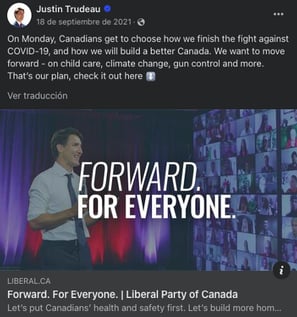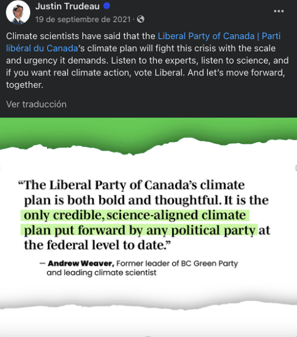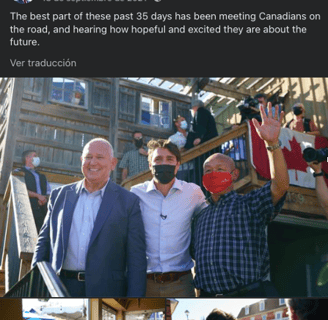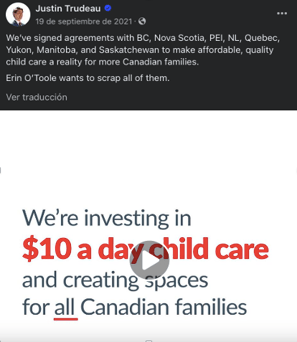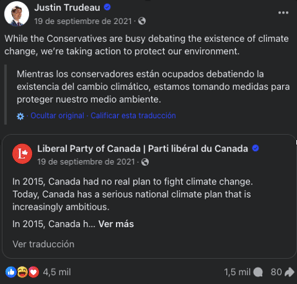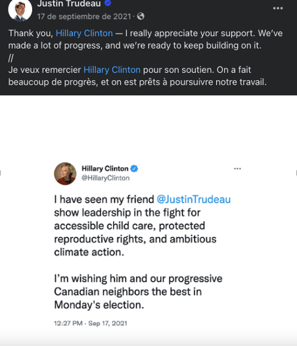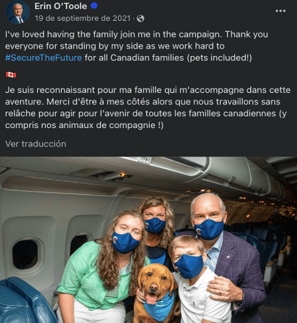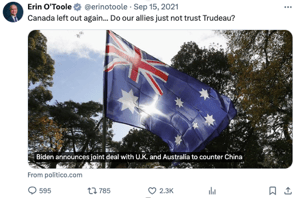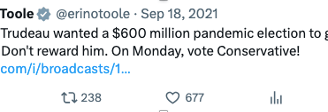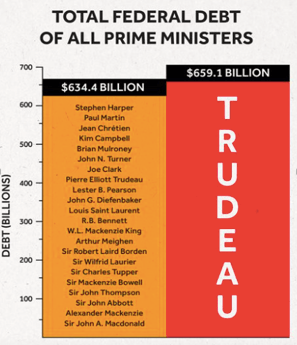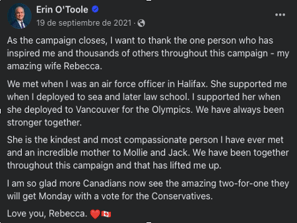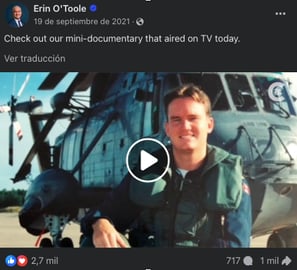A Comparative Analysis of Branding Strategies in the 2021 Canadian Federal Election Campaign: Justin Trudeau vs. Erin O'Toole
During my Public Policy and the Media course, I conducted an in-depth analysis of the branding strategies used by Justin Trudeau and Erin O'Toole in the 2021 Canadian federal election. This paper explores how both leaders crafted their public images, leveraged social media, and framed their campaign narratives to connect with voters. By examining key messages, digital engagement, and branding tactics, the study highlights the role of political branding in shaping public perception and influencing electoral outcomes.
Diana Castillo
3/19/202411 min read
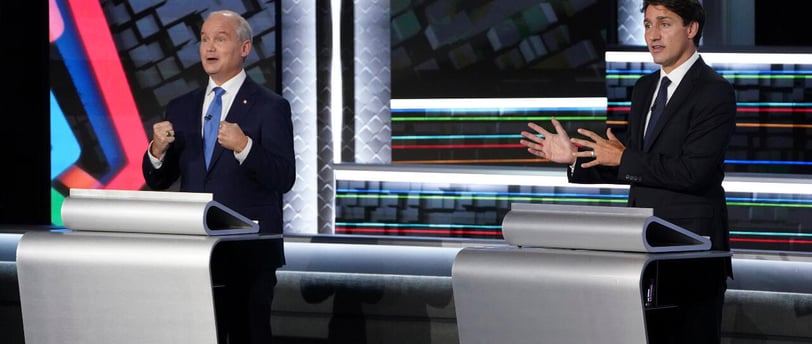

Held against the backdrop of a variant-fueled fourth wave of COVID-19, an affordable housing crisis, growing climate concerns and a continued economic uncertainty, Canadians went to the polls and re-elected a Liberal minority federal government on September 20, 2021, after a snap election. While a minority government was the most likely outcome, it’s now up to the Liberal party to maintain the country’s confidence (Grant Thornton LLP Canada 2021). Political parties wage a permanent campaign of constant communications, especially if they have access to government resources. A “brand” is a non-physical communications entity; it is the sum of all media impressions in a consumer’s mind that over time become a collection of evoked symbols and heuristic cues. As public figures, politicians develop a brand that is a combination of their actual personality, their own communication, messages from opponents, and a mediated image crafted by the news media. Branding a leader requires that public relations (PR) staff engage in reputation management by emphasizing some of that person’s characteristics while concealing others (Marland, Giasson and Small 2015).
Brief Background of the Candidates
Justin Trudeau, one of the main candidates for the 2021 federal election, epitomized a youthful, progressive leader who preached the values of inclusivity, social justice, and environmental sustainability. As the leader of the Liberal Party of Canada, Trudeau led policies focusing on economic recovery post-pandemic, climate action, and social welfare initiatives. The liberal party positioned itself as a centrist, pragmatic force in Canadian politics, advocating for progressive reforms while maintaining fiscal responsibility (ChatGPT 2024). Erin O’Toole, another one of the main candidates for the 2021 federal election, embodied a conservative personality based on traditional values, fiscal responsibility, and economic growth. As the leader of the Conservative Party of Canada, O’Toole led a campaign advocating for lower taxes, a streamlined government, and a tough-on-crime approach, appealing to a base supportive of conservative principles and policies. The Conservative Party positioned itself as a center-right alternative to the Liberals, prioritizing free-market solutions and national security (ChatGPT 2024). Social media has become an essential tool for modern campaigns in the political sphere, providing a direct line of communication for politicians to interact with people, spread their message, and rally support. Real-time contact is made possible by social media platforms like Facebook, Twitter, and Instagram. This gives candidates the ability to craft narratives, address criticism, and mobilize their supporters—all of which have a substantial impact on the outcome of elections.
Overview of Justin Trudeau’s 2021 Federal Election Campaign Brand
After analyzing data from the Liberal Party 2021 Platform and Justin Trudeau’s Facebook and Twitter posts from the 2021 federal election campaign, here are some insights of what branding for the Liberal candidate looked like. Trudeau’s campaign aimed to convey messages of hope, progress, and unity, emphasizing themes of inclusivity, diversity, and social justice (See Fig. 1). His key messages included commitments to building back better post-pandemic, advancing climate action (See Fig. 2), strengthening healthcare, and supporting economic recovery. Based on his Facebook posts, Trudeau’s campaign used emotive storytelling, personal anecdotes, and visual imagery to connect with voters on an emotional level. He presented himself as a family man and a leader involved within the community (See Fig. 3 and 4). His messages highlighted his leadership qualities and presented him as a compassionate and visionary leader able to guide Canada to recover from the pandemic and get through the challenging times.
Trudeau’s campaign, for the most part, generally avoided negative attacks on opponents, and instead focused on promoting its own accomplishments and future plans. “We’re facing two very different paths, between a Conservative Party that will take Canada backwards or a government that always has your back,” quotes one of the promotional videos posted by Trudeau on his Facebook page prior to the election (See Fig. 5). In another post he made on his Facebook page, he wrote “We’ve signed agreements with BC, Nova Scotia, PEI, NL, Quebec, Yukon, Manitoba, and Saskatchewan to make affordable, quality child care a reality for more Canadian families. Erin O’Toole wants to scrap all of them.” (See Fig. 6) Another post stated “While the conservatives are busy debating the existence of climate change, we’re taking action to protect the environment.” (See Fig. 7) These were among the few posts that targeted the Conservative Party or its leader Erin O’Toole. Overall, Trudeau steered clear of controversial issues, opting for a more inclusive and positive approach.
His campaign utilized innovative tools such as interactive websites. The Liberal Party 2021 Platform had an overview of their top priorities at the time of the election which included finishing the fight against COVID-19, a home for everyone, better healthcare for everyone, a more resilient economy, a cleaner, greener future, and reconciliation. It also included all platform commitments like Mandatory Vaccination, Support Implementation of Federal LGBTQ2 Action Plan, Zero Emissions Vehicles, $10 a Day Childcare for Families, Women in the Economy, among others (2021 Platform | Liberal Party of Canada n.d.). Trudeau also used the support of well-known personalities like Hillary Clinton (See Fig. 8) and Barack Obama, lobbying, and popular culture as a means of increasing appeal and legitimacy. The Liberal Platform also had the party slogan which was “Forward. For Everyone.” The party advocated for prioritizing Canadians' health, addressing middle-class concerns, supporting families with affordable childcare, and tackling climate change and systemic issues. The slogan emphasizes the need to move forward rather than regress, presenting the platform as a pathway for the country's future (2021 Platform | Liberal Party of Canada n.d.).
In general, Trudeau's branding efforts stayed true to his pre-existing political identity, presenting himself as a progressive and visionary leader. The transparency with which the campaign handled its issues and problems added to its genuineness. For the most part, Trudeau's branding approach succeeded in enhancing his reputation as a progressive leader dedicated to constructive change. helped keep the Liberal Party's core support base intact while drawing in a wider range of younger and more diverse voters. But criticism surfaced about the campaign's lack of specific policy ideas and excessive reliance on Trudeau's charisma, which certain voter segments may have found unfavorable.
Overview of Erin O’Toole’s 2021 Federal Election Campaign Brand
After analyzing data from the Conservative Party 2021 Platform and Erin O’Toole’s Facebook and Twitter posts from the 2021 federal election campaign, here are some insights of what branding for the Conservative candidate looked like. O’Toole’s campaign aimed to portray messages of economic recovery, fiscal responsibility, law and order, and national unity. Some of the key themes included promises to revitalize the economy, the creation of more jobs, a balanced budget and affordability. His campaign employed a straightforward and pragmatic approach, making an emphasis on his military background and experience in public service to transmit a sense of leadership. He used traditional conservative rhetoric and values to appeal to the party’s base, focusing on stability, security, and traditional family values (See Fig.9).
O’Toole’s campaign generally avoided some social issues, such as the LGBTQ+ rights and abortion. In many of his Facebook posts, instead of focusing on policy differences and contrasting visions for Canada’s future, he opted for backlash against his opponent, Justin Trudeau (See Fig. 10). One of his tweets from September 18, 2021, wrote the following, “Trudeau wanted a $600 million pandemic election to get more power. Don’t reward him. On Monday, vote Conservative!” (See Fig. 11) He also made a tweet on the skyrocketing costs of living under Trudeau and a post on his Facebook page about the total federal debt of all prime ministers (See Fig. 12).
His campaign targeted messaging tailored to specific demographics, including suburban voters, small business owners, and families to resonate with diverse segments of the electorate. O’Toole also used digital advertising and social media to amplify key campaign messages and engage with potential supporters online. While campaigning, we can see how he also portrays himself as a family man, posting pictures and thanking his wife for supporting him in his journey (See Fig. 13). He also released a mini documentary about himself to sympathize more with his followers (See Fig.14). Aiming for authenticity and integrity, O'Toole's branding activities often matched his well-established political reputation as a pragmatic and moderate conservative. O'Toole's branding strategy, which catered to conservative interests and values, was moderately successful in enhancing his reputation as a steady and capable leader. He worked to draw in moderate and unsure voters while simultaneously assisting in keeping the Conservative Party's core supporters. It was difficult to set O'Toole apart from his predecessors and to overcome unfavorable opinions about the Conservative Party's prior performance, which might have reduced the campaign's overall efficacy.
Importance of Branding in Political Election Campaigns
Branding can make or break a campaign, and as such, it has a long and storied history in politics. When new media develops, not knowing how to utilize it can be costly and nowadays political branding is a necessity that politicians can’t ignore (Zimmer 2017). Based on the analysis of Justin Trudeau's and Erin O'Toole's 2021 Federal Election Campaign Brands, it's evident that party and leader branding play pivotal roles in shaping public perception and voter behavior during electoral campaigns. Both candidates strategically crafted their campaign messages to align with their respective party's values and priorities while leveraging their personal attributes to connect with voters.
In general, both Trudeau and O'Toole showed how crucial it is for branding attempts to be genuine and consistent, matching their campaign slogans with their pre-existing political personas. By successfully reiterating his position as a progressive leader dedicated to constructive change, Trudeau was able to retain the support of his party's core supporters and draw in a larger voter base. However, complaints about the over-reliance on Trudeau's personality and the absence of concrete policy recommendations emerged. By contrast, O'Toole's branding approach was successful in attracting moderate voters while retaining support from the core of the Conservative Party by appealing to conservative interests and principles. However, difficulties emerged in setting O'Toole apart from his forerunners and debunking unfavorable opinions about the Conservative Party's previous record, which had an effect on the campaign's overall efficacy.
Creating a branding strategy for a political leader requires a comprehensive understanding of their strengths and weaknesses, as well as an analysis of the political landscape and target audience (ChatGPT 2024). Party and leader branding are integral components of successful electoral campaigns, influencing voter perceptions, and shaping election outcomes. Strong communication skills, reputation for integrity and honesty, and a charismatic and relatable personality to voters are essential for effective branding strategies. On the other hand, some weaknesses like vulnerability attacks from opponents, limited experience in high-level government positions or lack of recognition could be also used to enhance a branding strategy. Focusing on the ability to build consensus and collaborate with stakeholders, engaging in media appearances and deploying targeted advertising campaigns to raise awareness on a person’s candidacy and ideas, as well as being active on social media to reach more audiences and develop proactive messaging to counter negative narratives and emphasize a leader’s strengths and qualifications for the position. By leveraging a candidate’s strengths and weaknesses through a strategic branding approach, it will position the person as a compelling and viable candidate for political office (ChatGPT 2024).
Conclusion
In conclusion, the 2021 federal election in Canada saw Canadians re-elect a Liberal minority federal government amidst challenges such as the COVID-19 pandemic, affordable housing crisis, and climate concerns. Justin Trudeau's campaign emphasized progressive values of inclusivity, social justice, and environmental sustainability, while Erin O'Toole's campaign focused on traditional conservative principles of fiscal responsibility and economic growth. Both candidates utilized social media extensively to convey their messages and engage with voters. The effectiveness of their branding strategies varied, with Trudeau reinforcing his image as a progressive leader, albeit criticized for relying too heavily on his personality, while O'Toole successfully appealed to conservative interests but struggled to differentiate himself from his predecessors. This case study highlights the importance of authenticity, consistency, and strategic communication in political branding, as well as the need to leverage a candidate's strengths and address weaknesses to position them effectively in the eyes of the electorate.
Appendix
Figure 1
Figure 2
Figure 3
Figure 4
Figure 5
Figure 6
Figure 7
Figure 8
Figure 9
Figure 10
Figure 11
Figure 12
Figure 13
Figure 14
References
“2021 Platform | Liberal Party of Canada.” n.d. https://liberal.ca/our-platform/.
Grant Thornton LLP Canada. 2021. “2021 Post-federal Election Analysis,” September 21, 2021. https://www.grantthornton.ca/insights/2021-post-federal-election-analysis/.
Marland, Alex, Giasson, Thierry, and Small, Tamara A., eds. Political Communication in Canada : Meet the Press and Tweet the Rest. Vancouver: UBC Press, 2015. Accessed March 20, 2024. ProQuest Ebook Central.
OpenAI. (2024). ChatGPT. https://www.openai.com/chatgpt [“Provide me an outline to write a case study based on the following question: Compare and contrast that data between Justin Trudeau and Erin O'Toole on the 2021 federal election campaign, what messages are they trying to portray, how are they trying to portray those messages, what are they avoiding, was anything unique or creative done in the campaign, the authenticity of the branding initiatives and explain whether you think the branding strategy was effective? Can you evaluate the success of that branding strategy? Finally, based on your analysis, how important do you believe party or leader branding is in campaigns and what components particularly help an effective branding strategy?”]
OpenAI. (2024). ChatGPT. https://www.openai.com/chatgpt [“Create a branding strategy that takes into consideration the strengths and weaknesses of a political leader.”]
OpenAI. (2024). ChatGPT. https://www.openai.com/chatgpt [“Provide me a brief background of the candidate Justin Trudeau during the 2021 Federal Election Campaign.”]
OpenAI. (2024). ChatGPT. https://www.openai.com/chatgpt [“Provide me a brief background of the candidate Erin O’Toole during the 2021 Federal Election Campaign.”]
Zimmer, Mark. 2017. “Why Branding Is Critical During a Political Campaign.” September 28, 2017. https://info.zimmermarketing.com/blog/why-branding-is-critical-during-a-political-campaign.
